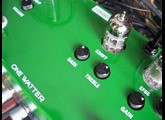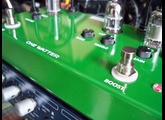« Pro Sound in a Small Package (for practice or studio recording) »
Published on 01/17/22 at 13:48
Best value:
Correct
Audience:
Anyone
Hagerman designed a low watt amplifier for the primary purpose of a practice amp, in order to avoid using and burning up a larger stage amp at home. I can expand on that premise to suggest that many times bands leave gear in a particular location, to prevent having to haul amps, cabs, etc., back and forth. It would make sense that you have some type of practice amp at home, which brings us to inexpensive modelers, which often are good enough for practice. It may be asked why invest in a low-watt tube amp, the ONE WATTER, as an alternative? I see this from two angles. First, there is a tone difference with real tube amps versus modeling gear; the latter may have come a long way, but there’s a certain element of warmth and sponginess that comes with real tubes for those tube snobs uninterested in modeling. Nothing wrong with using or refusing modelers. Second, the ONE WATTER also was designed for direct recording. This amp will drive any 8-to-16 ohm speaker cabinet, but if using a TRS cable (amp out), you can bypass the cab and go direct to a mixer, interface, etc., and use whatever cab sims preferred.
The ONE WATTER has a clean channel and a boosted channel. The clean channel sounds very clean with single-coils, and fairly clean with humbuckers (a bit of hair, but if you dial back on the guitar’s volume, it becomes very clean). To avoid any modest grit with humbuckers, using the guitar’s volume is key, as the amp’s volume will not change that characteristic. The clean channel uses a 12BH7 tube, which also is driven by a 12AY7 tube (paralleled sections) running single-ended into an oversized output transformer. The boost channel offers up to +28dB gain boost (150 to 3kHz). It utilizes an EF86 tube that adds 2nd harmonic warmth to the tone, but also overdrives the first 12AY7 stage, thus giving it a slight treble boost (to reduce mud), and also a breakup sound that ranges from a hint of grit (turned all the way down) to classic rock dirt and crunch when pushed past 12-noon.
With the boost on and gain all the way up, there is enough drive to produce decent lead tones (I like crunch with the Gain set around 11 to 1-o’clock). But it takes only a basic drive pedal to make it sing with sustain. And certainly, you can add drives and distortions on the already boosted channel, but the clean channel sounds excellent on its own as a pedal platform, whether using a basic blues driver, fuzz, or delving into modern metal pedals.
Now, in the first demo I indicated that this amp reminded me a lot of Fender amps, insofar as its tone. However, Jim Hagerman offered these tips, which I demo in the second video:
“Tone controls are pretty flat at noon, so a bit like a tweed. Set both BASS & TREBLE to maximum and you get a Fender blackface sort of midrange dip. In between is Marshally (both at 3-o’clock?).”
There is a volume increase when engaging the boost, increasing drive, and increasing either EQ control (60Hz to 6kHz bandwidth), and so, some tweaking is required to obtain proper sound levels (same as with any amp). On that note, this is a ONE WATTER when using the clean channel, but it does increase to 3-watts (at 8 ohms) with the boost engaged. That may not sound like much, but it’s irrelevant for direct recording and still pretty darn loud going through a cab for in-home practice (loud enough to annoy others in your house or with apartment-dwelling neighbors).
The Hagerman quality definitely is in this 5Ω output impedance amp, and there’s no denying the company’s standards. Very nice tones! I also like its size, at only 9x5x4.5 inches, making it ideal for pedalboard or desktop. It comes with its own 15Vdc power supply (@17W) and a very well-built and attractive chassis. The price is reasonable ($439 USD), considering it’s a tube amp, sounds fantastic, is ideal for quality recording (besides home practice), and makes for an excellent pedal platform. I don’t consider the exposed tubes to be a factor, since it’s not meant to be carted about (FYI, if you’re experimental, you can try different tubes). The ONE WATTER’s only downfall is that it does not have an FX Loop, which can be a deal breaker for some, depending how you need to hook up your gear for practice or recording.
The ONE WATTER has a clean channel and a boosted channel. The clean channel sounds very clean with single-coils, and fairly clean with humbuckers (a bit of hair, but if you dial back on the guitar’s volume, it becomes very clean). To avoid any modest grit with humbuckers, using the guitar’s volume is key, as the amp’s volume will not change that characteristic. The clean channel uses a 12BH7 tube, which also is driven by a 12AY7 tube (paralleled sections) running single-ended into an oversized output transformer. The boost channel offers up to +28dB gain boost (150 to 3kHz). It utilizes an EF86 tube that adds 2nd harmonic warmth to the tone, but also overdrives the first 12AY7 stage, thus giving it a slight treble boost (to reduce mud), and also a breakup sound that ranges from a hint of grit (turned all the way down) to classic rock dirt and crunch when pushed past 12-noon.
With the boost on and gain all the way up, there is enough drive to produce decent lead tones (I like crunch with the Gain set around 11 to 1-o’clock). But it takes only a basic drive pedal to make it sing with sustain. And certainly, you can add drives and distortions on the already boosted channel, but the clean channel sounds excellent on its own as a pedal platform, whether using a basic blues driver, fuzz, or delving into modern metal pedals.
Now, in the first demo I indicated that this amp reminded me a lot of Fender amps, insofar as its tone. However, Jim Hagerman offered these tips, which I demo in the second video:
“Tone controls are pretty flat at noon, so a bit like a tweed. Set both BASS & TREBLE to maximum and you get a Fender blackface sort of midrange dip. In between is Marshally (both at 3-o’clock?).”
There is a volume increase when engaging the boost, increasing drive, and increasing either EQ control (60Hz to 6kHz bandwidth), and so, some tweaking is required to obtain proper sound levels (same as with any amp). On that note, this is a ONE WATTER when using the clean channel, but it does increase to 3-watts (at 8 ohms) with the boost engaged. That may not sound like much, but it’s irrelevant for direct recording and still pretty darn loud going through a cab for in-home practice (loud enough to annoy others in your house or with apartment-dwelling neighbors).
The Hagerman quality definitely is in this 5Ω output impedance amp, and there’s no denying the company’s standards. Very nice tones! I also like its size, at only 9x5x4.5 inches, making it ideal for pedalboard or desktop. It comes with its own 15Vdc power supply (@17W) and a very well-built and attractive chassis. The price is reasonable ($439 USD), considering it’s a tube amp, sounds fantastic, is ideal for quality recording (besides home practice), and makes for an excellent pedal platform. I don’t consider the exposed tubes to be a factor, since it’s not meant to be carted about (FYI, if you’re experimental, you can try different tubes). The ONE WATTER’s only downfall is that it does not have an FX Loop, which can be a deal breaker for some, depending how you need to hook up your gear for practice or recording.










